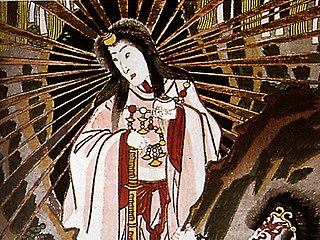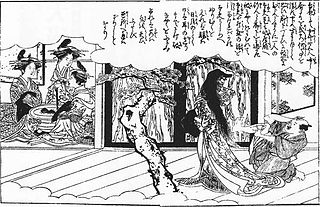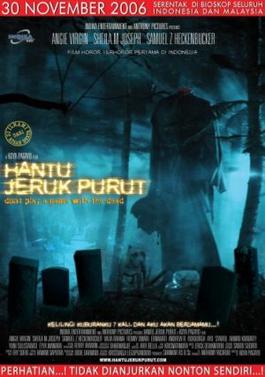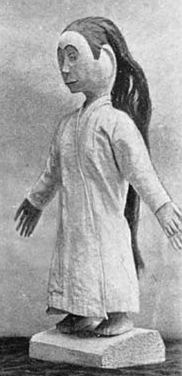
La Llorona is a Mexican vengeful ghost who is said to roam near bodies of water mourning her children whom she drowned in a jealous rage after discovering her husband was cheating on her.

The bogeyman is a mythical creature used by adults to frighten children into good behaviour. Bogeymen have no specific appearance and conceptions vary drastically by household and culture, but they are most commonly depicted as masculine or androgynous monsters that punish children for misbehaviour. The bogeyman and conceptually similar monsters can be found in many cultures around the world. Bogeymen may target a specific act or general misbehaviour, depending on the purpose of invoking the figure, often on the basis of a warning from an authority figure to a child. The term is sometimes used as a non-specific personification of, or metonym for, terror, and sometimes the Devil.

The Kuntilanak, also called Pontianak, or Yakshi in Hinduism/ Hindu mythology is a mythological creature in Indonesia, Malaysia and Singapore. It is similar to Langsuir in other Southeast Asia regions. The Pontianak usually takes the form of a pregnant woman who is unable to give birth to a child. Alternatively, it is often described as a vampiric, vengeful female spirit. Another form of the Pontianak refers to the ghost or white lady of Southeast Asian folklore.

In Japanese traditional beliefs and literature, onryō are a type of ghost believed to be capable of causing harm in the world of the living, injuring or killing enemies, or even causing natural disasters to exact vengeance to "redress" the wrongs it received while alive, then taking their spirits from their dying bodies. Onryō are often depicted as wronged women, who are traumatized by what happened during life and exact revenge in death.

Kuchisake-onna is a malevolent figure in Japanese urban legends and folklore. Described as the malicious spirit, or onryō, of a woman, she partially covers her face with a mask or other item and carries a pair of scissors, a knife, or some other sharp object. She is most often described as having long, straight, black hair, pale skin, and otherwise being considered beautiful . She has been described as a contemporary yōkai.
La Sayona is a legend from Venezuela, represented by the vengeful spirit of a woman that shows up only to men that have love affairs out of their marriages. The name "Sayona" refers to the cloth the ghost wears which is a long white dress similar to a medieval undergarment.

There are many Malay ghost myths, remnants of old animist beliefs that have been shaped by Hindu-Buddhist cosmology and later Muslim influences, in the modern states of Brunei, Indonesia, Malaysia, Singapore and among the Malay diaspora in neighbouring Southeast Asian countries. The general word for ghost is hantu, of which there exist a wide variety. Some ghost concepts such as the female vampires pontianak and penanggal are shared throughout the region. While traditional belief does not consider all ghosts as necessarily evil, Malaysian popular culture tends to categorise them all as types of evil djinn.

The Krasue is a nocturnal female spirit of Southeast Asian folklore. It manifests as the floating, disembodied head of a woman, usually young and beautiful, with her internal organs still attached and trailing down from the neck.

Pocong is a Javanese ghost that is said to be the soul of a dead person trapped in their shroud. Known in Indonesian as kain kafan, the shroud is the prescribed length of cloth used in Muslim burials to wrap the body of the dead person. The dead body is covered in white fabric tied over the head, under the feet, and on the neck.

Hantu Jeruk Purut is a 2006 Indonesian horror film directed by Koya Pagayo and starring Angie, Sheila Marcia Joseph, and Samuel Z Heckenbucker. It tells the story of an aspiring writer who is haunted by the ghost she is investigating.
In Indonesian mythology, a sundel bolong, is a mythical ghost from the archipelago which is a woman with beautiful long black hair and a long white dress. The myth is closely linked to prostitutes, meaning a "prostitute with a hole in her", in reference to the large hole which is said to appear in her back.

Malay folklore refers to a series of knowledge, traditions and taboos that have been passed down through many generations in oral, written and symbolic forms among the indigenous populations of Maritime Southeast Asia (Nusantara). They include among others, themes and subject matter related to the indigenous knowledge of the ethnic Malays and related ethnic groups within the region.
Hanako-san, or Toire no Hanako-san, is a Japanese urban legend about the spirit of a young girl named Hanako-san who haunts school toilets. Like many urban legends, the details of the origins of the legend vary depending on the account; different versions of the story include that Hanako-san is the ghost of a World War II–era girl who was killed while playing hide-and-seek during an air raid, that she was murdered by a parent or stranger, or that she committed suicide in a school toilet due to bullying.

The mythology of Indonesia is very diverse, the Indonesian people consisting of hundreds of ethnic groups, each with their own myths and legends that explain the origin of their people, the tales of their ancestors and the demons or deities in their belief systems. The tendency to syncretize by overlying older traditions with newer foreign ideas has occurred. For example, the older ancestral mythology might be merged with foreign mythology, such as Hindu, Islam, or Christian biblical mythology.
Daayan, Ḍāin or Ḍāini is often mistakenly regarded as a Bandariya for a witch in Indian folklore, the term has been derived from the Sanskrit word dakini, which refers to a female paranormal entity from patala. Dakinis have been described in medieval Hindu texts such as the Bhagavata Purana, Brahma Purana, Markandeya Purana and Kathasaritsagara as female fiendish spirits in the train of Kali who feed on human flesh.

Belief in ghosts in Thai culture is both popular and enduring. In the history of Thailand, Buddhist popular beliefs intermingled with legends of spirits or ghosts of local folklore. These myths have survived and evolved, having been adapted to the modern media, such as Thai films, Thai television soap operas, and Thai comics.

In mythology and folklore, a vengeful ghost or vengeful spirit is said to be the spirit of a dead person who returns from the afterlife to seek revenge for a cruel, unnatural or unjust death. In certain cultures where funeral and burial or cremation ceremonies are important, such vengeful spirits may also be considered as unhappy ghosts of individuals who have not been given a proper funeral.

The langsuyar, also lang suir or langsuir, is a female revenant in Malay and other mythologies in the Malay archipelago. The word is derived from the Malay word for eagle (helang).

Danur 2: Maddah is a 2018 Indonesian supernatural horror film directed by Awi Suryadi and written by Lele Laila. The film stars Prilly Latuconsina, Sandrinna Michelle and Shawri Adrian Khulafa in leading roles with Sophia Latjuba, Bucek Depp, and Gama Haritz in supporting roles. The film is the sequel to the 2017 film Danur: I Can See Ghosts, and is followed by Danur 3: Sunyaruri in 2019.













